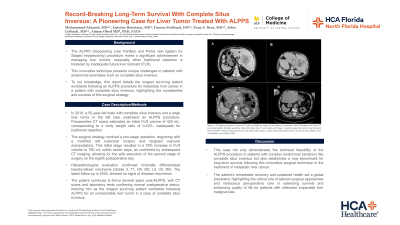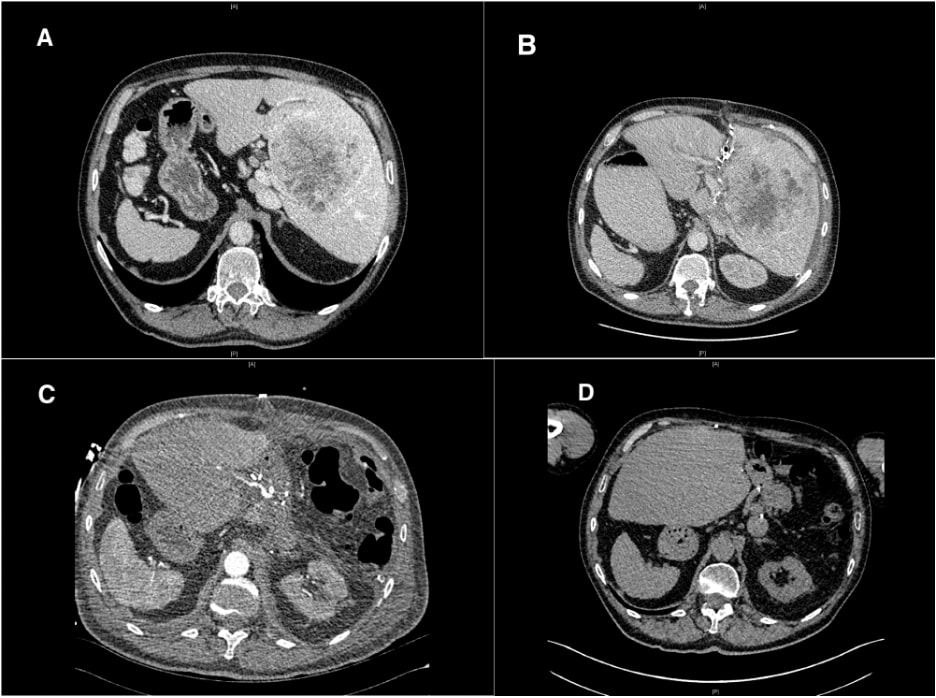Monday Poster Session
Category: Liver
P3143 - Record-Breaking Long-Term Survival With Complete Situs Inversus: A Pioneering Case for Liver Tumor Treated With ALPPS
Monday, October 28, 2024
10:30 AM - 4:00 PM ET
Location: Exhibit Hall E

Has Audio

Mohammad AbuAssi, MD
University of Central Florida, HCA Healthcare GME
Gainesville, FL
Presenting Author(s)
Mohammad Abuassi, MD1, Antoine Boustany, MD2, Yaseen Perbtani, DO3, Tony S.. Brar, MD3, John Leibach, MD4, Aiman Obed, MD, PhD5
1University of Central Florida, HCA Healthcare GME, Gainesville, FL; 2Cleveland Clinic Foundation, Cleveland, OH; 3University of Central Florida College of Medicine, Gainesville, FL; 4Digestive Disease Associates, Gainesville, FL; 5Jordan Hospital, Amman, 'Amman, Jordan
Introduction: The ALPPS (Associating Liver Partition and Portal vein ligation for Staged hepatectomy) procedure marks a significant advancement in managing liver tumors, especially when traditional resection is hindered by inadequate future liver remnant (FLR). This innovative technique presents unique challenges in patients with anatomical anomalies such as complete situs inversus. To our knowledge, this report details the longest surviving patient worldwide following an ALPPS procedure for metastatic liver cancer in a patient with complete situs inversus, highlighting the complexities and success of this surgical strategy.
Case Description/Methods: In 2010, a 55-year-old male with complete situs inversus and a large liver tumor in the left lobe underwent an ALPPS procedure. Preoperative CT scans estimated an initial FLR volume of 425 mL, corresponding to a body weight ratio of 0.42%, inadequate for traditional resection. The surgical strategy involved a two-stage operation, beginning with a modified left subcostal incision and targeted vascular manipulations. This initial stage resulted in a 79% increase in FLR volume to 760 mL within seven days, as confirmed by subsequent CT imaging, allowing for the safe execution of the second stage of surgery on the eighth postoperative day. Histopathological evaluation confirmed minimally differentiated hepatocellular carcinoma (Grade 3, T1, N0, M0, L0, V0, R0). The latest follow-up in 2024, showed no signs of disease recurrence. The patient continues to thrive several years post-ALPPS, with CT scans and laboratory tests confirming normal postoperative status, marking him as the longest surviving patient worldwide following ALPPS for an unresectable liver tumor in a case of complete situs inversus.
Discussion: This case not only demonstrates the technical feasibility of the ALPPS procedure in patients with complex anatomical variations like complete situs inversus but also establishes a new benchmark for long-term survival following this innovative surgical technique in the treatment of metastatic liver cancer. The patient's remarkable recovery and sustained health set a global precedent, highlighting the critical role of tailored surgical approaches and meticulous perioperative care in extending survival and enhancing quality of life for patients with otherwise inoperable liver malignancies.

Disclosures:
Mohammad Abuassi, MD1, Antoine Boustany, MD2, Yaseen Perbtani, DO3, Tony S.. Brar, MD3, John Leibach, MD4, Aiman Obed, MD, PhD5. P3143 - Record-Breaking Long-Term Survival With Complete Situs Inversus: A Pioneering Case for Liver Tumor Treated With ALPPS, ACG 2024 Annual Scientific Meeting Abstracts. Philadelphia, PA: American College of Gastroenterology.
1University of Central Florida, HCA Healthcare GME, Gainesville, FL; 2Cleveland Clinic Foundation, Cleveland, OH; 3University of Central Florida College of Medicine, Gainesville, FL; 4Digestive Disease Associates, Gainesville, FL; 5Jordan Hospital, Amman, 'Amman, Jordan
Introduction: The ALPPS (Associating Liver Partition and Portal vein ligation for Staged hepatectomy) procedure marks a significant advancement in managing liver tumors, especially when traditional resection is hindered by inadequate future liver remnant (FLR). This innovative technique presents unique challenges in patients with anatomical anomalies such as complete situs inversus. To our knowledge, this report details the longest surviving patient worldwide following an ALPPS procedure for metastatic liver cancer in a patient with complete situs inversus, highlighting the complexities and success of this surgical strategy.
Case Description/Methods: In 2010, a 55-year-old male with complete situs inversus and a large liver tumor in the left lobe underwent an ALPPS procedure. Preoperative CT scans estimated an initial FLR volume of 425 mL, corresponding to a body weight ratio of 0.42%, inadequate for traditional resection. The surgical strategy involved a two-stage operation, beginning with a modified left subcostal incision and targeted vascular manipulations. This initial stage resulted in a 79% increase in FLR volume to 760 mL within seven days, as confirmed by subsequent CT imaging, allowing for the safe execution of the second stage of surgery on the eighth postoperative day. Histopathological evaluation confirmed minimally differentiated hepatocellular carcinoma (Grade 3, T1, N0, M0, L0, V0, R0). The latest follow-up in 2024, showed no signs of disease recurrence. The patient continues to thrive several years post-ALPPS, with CT scans and laboratory tests confirming normal postoperative status, marking him as the longest surviving patient worldwide following ALPPS for an unresectable liver tumor in a case of complete situs inversus.
Discussion: This case not only demonstrates the technical feasibility of the ALPPS procedure in patients with complex anatomical variations like complete situs inversus but also establishes a new benchmark for long-term survival following this innovative surgical technique in the treatment of metastatic liver cancer. The patient's remarkable recovery and sustained health set a global precedent, highlighting the critical role of tailored surgical approaches and meticulous perioperative care in extending survival and enhancing quality of life for patients with otherwise inoperable liver malignancies.

Figure: This figure presents a series of CT scans at different stages of the patient's treatment. Panel (A) displays the initial CT scan taken before the first operation. Panel (B) shows the CT scan taken post Stage 1, used to assess the Future Liver Remnant Volume (FLRV). Panel (C) illustrates the CT scan taken after Stage 2. Lastly, Panel (D) presents the CT scan from the patient's most recent follow-up in 2023.
Disclosures:
Mohammad Abuassi indicated no relevant financial relationships.
Antoine Boustany indicated no relevant financial relationships.
Yaseen Perbtani indicated no relevant financial relationships.
Tony Brar indicated no relevant financial relationships.
John Leibach indicated no relevant financial relationships.
Aiman Obed indicated no relevant financial relationships.
Mohammad Abuassi, MD1, Antoine Boustany, MD2, Yaseen Perbtani, DO3, Tony S.. Brar, MD3, John Leibach, MD4, Aiman Obed, MD, PhD5. P3143 - Record-Breaking Long-Term Survival With Complete Situs Inversus: A Pioneering Case for Liver Tumor Treated With ALPPS, ACG 2024 Annual Scientific Meeting Abstracts. Philadelphia, PA: American College of Gastroenterology.
